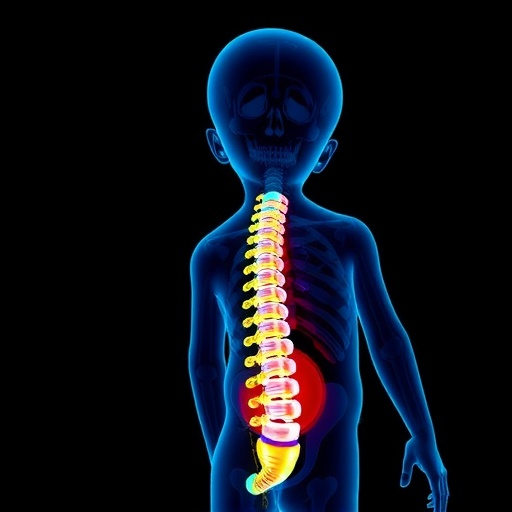In a ground-breaking study published in World Journal of Pediatrics, researchers Tao, Zhao, and Wu have unveiled comprehensive trends in pediatric spinal cord injury (SCI) burden across China and globally, spanning three decades from 1990 to 2021, with forecasting models extending to 2045. This meticulous investigation not only quantifies the shifting landscape of pediatric SCI incidence and prevalence but also projects future trajectories that have profound implications for healthcare planning, resource allocation, and preventative strategies worldwide.
Spanning an impressive timeline of over 30 years, the study meticulously analyzes vast datasets, integrating epidemiological records, hospital registries, and national health surveys. By employing sophisticated statistical modeling and predictive algorithms, the investigators dissect nuanced patterns of SCI in children, identifying temporal changes driven by socio-economic evolution, improved trauma care, and regional disparities in risk factors. This temporal depth offers an unrivaled vantage point to understand how pediatric SCI epidemiology has evolved under the pressures of modern development and shifting demographics.
One of the study’s cornerstone findings highlights the contrasting trends between developed regions and low-to-middle-income settings, with China’s pediatric SCI burden serving as a critical case study. The data reveals that while some high-income countries have achieved modest declines in SCI incidence due to advancements in safety regulations, emergency medical protocols, and public awareness, China’s rapid urbanization and increasing pediatric population have paradoxically contributed to rising SCI rates in certain provinces. These findings underscore the complexity of injury prevention in dynamically changing societies.
Delving deeper into the data, the study presents detailed stratification by age groups, injury severity, and mechanism of injury. Notably, the highest incidence rates are observed in children aged 5 to 14 years, a demographic particularly vulnerable due to increased mobility and engagement in high-risk activities. The researchers emphasize that traumatic events such as falls, motor vehicle accidents, and sports-related injuries remain predominant contributors to SCI, with region-specific variations linked to cultural and infrastructural factors.
The authors further illuminate disparities in outcomes post-injury, drawing attention to the differential access to rehabilitation services and long-term care support. In low-resource settings, protracted recovery periods and higher rates of secondary complications magnify the lifetime burden of SCI. By contrast, regions with well-developed pediatric neurology and rehabilitation systems report improved prognoses, accentuating the critical role of healthcare infrastructure in mitigating the societal impact of pediatric SCI.
A defining element of this investigation is its robust forecasting framework, employing machine learning-based projection models that simulate epidemiological trajectories up to mid-century. These projections anticipate an overall global increase in the pediatric SCI burden, driven largely by demographic shifts including population growth and improved survival rates from otherwise fatal injuries. Importantly, the model estimates that China will experience a heterogeneous burden distribution, with urban centers showing stabilization or slight reductions due to enhanced safety measures, whereas rural and less developed areas may see upticks absent targeted interventions.
The global context provided by the study reveals that pediatric SCI constitutes not merely a medical challenge but a multifaceted socio-economic issue. Lifelong disabilities from early-age SCIs impose profound emotional, financial, and societal costs, necessitating integrated policies that encompass prevention, acute management, and chronic care. The researchers advocate for enhanced injury surveillance systems worldwide to monitor emerging trends and evaluate the efficacy of interventions in real-time.
Technologically, the work leverages advanced geographic information systems (GIS) to map incident hotspots and to identify vulnerable populations with precision. This spatial analysis facilitates targeted interventional strategies, enabling policymakers to allocate resources more efficiently. Moreover, the study encourages incorporation of emerging tools such as wearable sensors and AI-driven diagnostics in early risk screening among pediatric cohorts.
In addressing prevention, the authors call for multifactorial approaches involving legislative reinforcement for child safety in vehicles, playgrounds, and schools, alongside broad public health campaigns to raise awareness on accident prevention. Interdisciplinary collaboration among pediatricians, neurosurgeons, educators, and policy experts is posited as vital to forging sustainable pathways toward diminishing pediatric SCI incidence.
The findings have broad ramifications for the design of rehabilitation paradigms tailored to pediatric needs. Unlike adults, children face unique neurodevelopmental challenges post-SCI, requiring adaptation of therapeutic modalities to optimize neuroplasticity and functional recovery. The study proposes investment in pediatric-specific rehabilitation research to innovate evidence-based protocols that consider age-dependent biomechanical and psychological factors.
Additionally, the researchers draw attention to the underrecognized mental health sequelae of pediatric SCI, including anxiety, depression, and social isolation, which significantly influence quality of life. Integration of psychological support within comprehensive care models emerges as a pivotal recommendation, warranting policy attention and funding.
This landmark study’s predictive insights are especially pertinent amidst the ongoing global demographic transitions with aging populations and urban expansions altering injury epidemiology profiles. The authors highlight the necessity for continuous data updates and adaptive modeling frameworks to refine future predictions and to remain responsive to emerging public health realities.
In conclusion, the investigation by Tao, Zhao, and Wu sets a new benchmark in understanding the pediatric spinal cord injury burden on a global scale. By combining rigorous epidemiological analysis with forward-looking projection models, this research equips clinicians, policymakers, and public health leaders with actionable intelligence to confront the multifaceted challenges posed by pediatric SCIs. The compelling evidence underscores an urgent call to global action aimed at prevention, optimized care delivery, and robust support systems to alleviate the enduring impact of these life-altering injuries on children and societies alike.
Subject of Research: Pediatric spinal cord injury epidemiology and burden analysis with projections
Article Title: Chinese and global trends in pediatric spinal cord injury burden (1990–2021) with projections to 2045
Article References:
Tao, YP., Zhao, CH. & Wu, JG. Chinese and global trends in pediatric spinal cord injury burden (1990–2021) with projections to 2045. World J Pediatr (2025). https://doi.org/10.1007/s12519-025-00991-7
Image Credits: AI Generated
DOI: 10.1007/s12519-025-00991-7
Keywords: Pediatric spinal cord injury, epidemiology, burden, China, global trends, projections, prevention, rehabilitation, public health, injury surveillance




